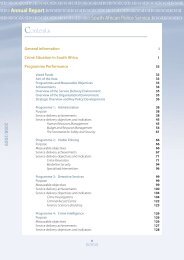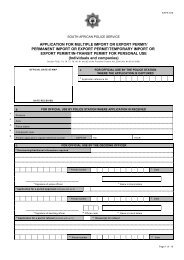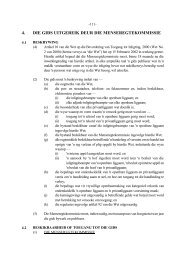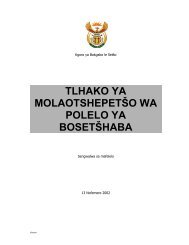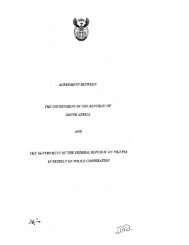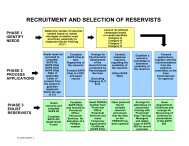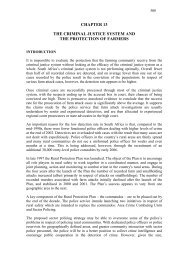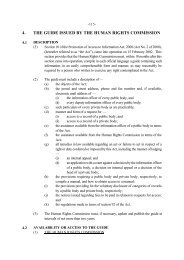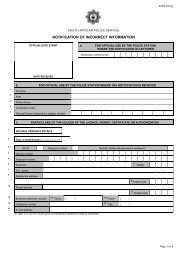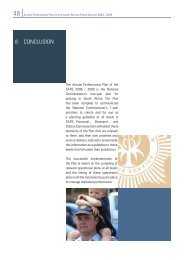Untitled - Saps
Untitled - Saps
Untitled - Saps
Create successful ePaper yourself
Turn your PDF publications into a flip-book with our unique Google optimized e-Paper software.
1997<br />
10 Years of Policing in a Democracy 1995 – 2005<br />
30<br />
• In order to extend the National Crime Prevention Strategy to needs-driven provincial<br />
and local initiatives, nine provincial crime summits were held in 1997. These summits<br />
led to the adoption of a number of primary crime-prevention programmes. At the<br />
beginning of 1997, the NCPS Committee of Ministers identified a number of projects<br />
to be carried out by the participating departments. The largest of the projects was the<br />
Integrated Justice System (IJS). The aim of the project was to streamline the judicial<br />
process and to support it with the Information Management System so that offenders<br />
could be effectively managed and tracked through the entire criminal justice system.<br />
• Furthermore, several interdisciplinary and intersectorial task team projects were<br />
launched regarding firearm control, border control, vehicle crime, violence and crimes<br />
against women and children, including domestic violence, corruption in the criminal<br />
justice system and escapes from custody.<br />
• In April 1997, the then President, Nelson Mandela, announced that the government<br />
had launched a series of high-density crime-prevention operations to fight crime. The<br />
operations involved the SAPS, the SANDF and the intelligence services. The primary<br />
objective of the operations was to crack down on illegal firearms and organized crime.<br />
• In May 1997, more than 1 500 stolen South African vehicles were recovered in an anticrime<br />
operation spanning four southern African countries. Operation V4 involved police<br />
members from South Africa, Mozambique, Zimbabwe and Zambia and was sponsored<br />
by the Kingdom of Belgium.<br />
• In May 1997, the moratorium on police recruitment, imposed by the government in<br />
1994, was lifted. It was also announced that an extra 5 250 police officials and civilian<br />
employees would be appointed in line with the new approach to recruitment.<br />
• A team of senior British police officers arrived in South Africa at the end of June. They<br />
worked closely with the Department of Safety and Security and the SAPS to review<br />
existing systems of management, training, evaluation and monitoring. At the end of July<br />
1997, a task team appointed by the Minister proposed that the government consider<br />
decentralizing certain police functions to the provinces.<br />
• In June 1997, the Minister for Safety and Security revealed that the SAPS was involved in<br />
major anti-crime operations in cooperation with the Mozambican police. The operations<br />
were aimed at stemming the tide of illegal firearms entering the country, as well as crossborder<br />
vehicle theft. Earlier in the year, a joint operation by the two countries had led to<br />
the destruction of a big arms cache near Xai-Xai in Mozambique. In July and August,<br />
thousands of weapons and millions of rounds of ammunition were located and destroyed<br />
during a joint operation between the South African and Mozambican police.<br />
• At the end of October 1997, the newly adopted Code of Conduct, which had been<br />
extended to all members to create a safe and secure environment for all South Africans<br />
in a democratic framework, was signed for the first time.<br />
• The 1997/1998 Annual Police Plan identified five policing priorities and six organizational<br />
focus areas to improve service delivery and the utilization of resources to combat and<br />
prevent crime more effectively. The focus areas were the quality of investigative services,<br />
victim empowerment, budget and resource management, performance appraisal and<br />
service monitoring, affirmative training and communication. The policing priorities were<br />
firearms, criminal organizations, crimes against women and children, corruption in the<br />
criminal justice system and crime prevention.<br />
• In August 1997, the United States government sent representatives of four federal law<br />
enforcement agencies to South Africa to cooperate in the fight against international<br />
crime syndicates and to assist with local training programmes. The agents concerned<br />
were attached to the US embassy in Pretoria and represented the Federal Bureau of<br />
Investigation (FBI), the Drug Enforcement Administration, the US Customs Service and<br />
the Immigration and Naturalization Service.<br />
• In October 1997, the Rural Protection Plan (RPP), aimed at protecting farmers, was<br />
launched. The RPP involved the National Defence Force, police Rests, special police<br />
units and the intelligence services.<br />
• In order to streamline a number of projects in the SAPS, management decided to<br />
amalgamate all service delivery projects into the Service Delivery and Improvement<br />
Programme (SDIP). The main aim of SDIP was to create pockets of excellence in



